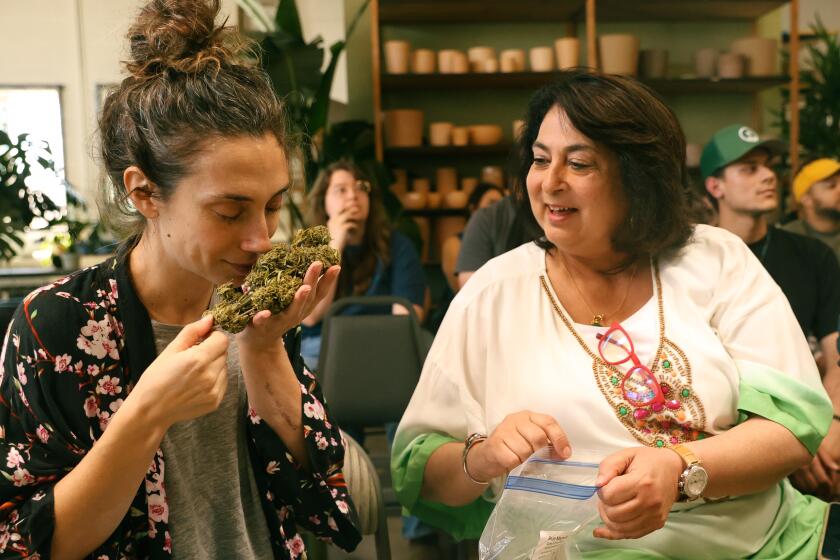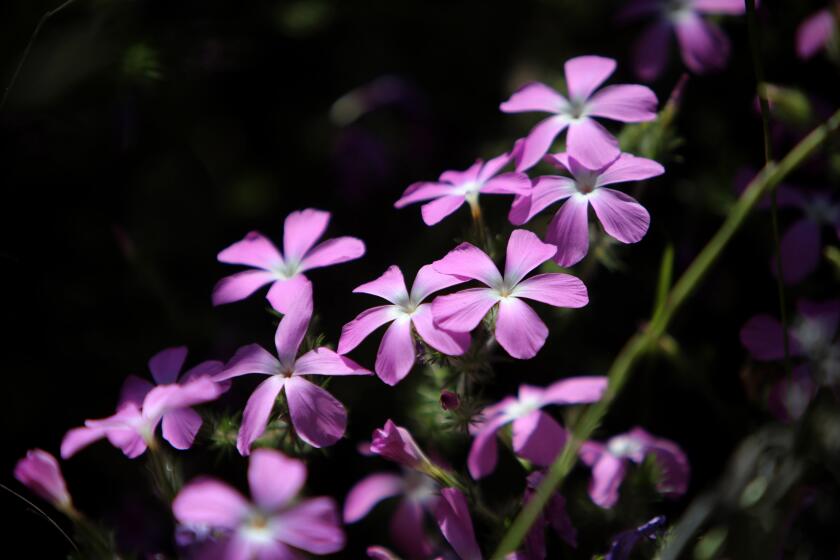Shades of Meaning : How Colors of Everything in a Home Influence Moods, Words, Thoughts
Are you feeling blue? In the pink? Ready to paint the town red?
However you’re feeling, color may be the reason. Research shows that colors affect our moods.
In “Living Color: Master Lin Yun’s Guide of Feng Shui and the Art of Color” (Kodansha International, $18) by Sarah Rossbach and Lin Yun, the authors write: “Whatever we look upon and see through our eyes will, through our optic nerve, send sensory signals to each area of the brain. . . . The colors of everything our eyes come in contact with will influence our temperament, physical movements, language and thoughts--in short, our lives.”
With this in mind, it’s surprising that so few people make use of the more than 6 million color possibilities when decorating their homes.
Mary Anna and Arthur Jeppe’s Newport Beach home is an exception. Their house has rooms painted in an array of colors, from a soft mint green in the family room (that shows off their ethnic art collection) to a flattering pinkish coral on the dining room walls (that takes years off everyone’s age) to periwinkle blue upstairs.
It’s in the living room, however, that the use of color to change mood is best illustrated. Mary Anna Jeppe had the walls of the room painted a soft yellow, not realizing at the time that she was painting the walls in accordance with the dictates of the 1,500-member Color Marketing Group, the nonprofit Virginia-based association that has dictated color trends for more than 30 years.
These are the people who gave us avocado refrigerators in the 1960s and mauve hotel rooms in the ‘70s.
“We are moving into a more optimistic time as we head toward the end of the century,” says Melanie Wood, association president. “Because of this, yellow and shades of yellow, from the very pale to rich gold, will be prominent. It will be as if we’re bathed year-round in sunshine.”
Colors for 1997-98 are called such things as limone (a yellow), salmon mousse, Creole spice, apache and mint cycle, among others. They were chosen based on a new interest in femininity, an increasing willingness by consumers to use color after years of whites and grays, as well as the more favorable changes economically and politically throughout the world.
“Yellow is a good color since it evokes a different emotion depending on what you put with it,” Wood continues. “With blue and white it’s cool, with red and brown it’s warm.”
Mary Anna Jeppe, a board member of New Directions for Women and the force behind the group’s annual decorative arts lecture series, is aware of just that. Twice a year with the seasons, she changes the slipcovers and accessories in the living room and, with them, the room’s ambience.
*
During the spring and summer, when the light is bright, the room looks like a flower-filled cheery day at the beach with its blue and white striped slipcovers, floral-patterned side chairs and tablecloth and blue and white porcelain.
A hand-painted tray on a stand doubles as a coffee table. During this time, the room extends into the outdoor patio and garden area through the open French doors. Even on the hottest day, the room remains cool.
But she also realized that during the fall and winter months she needed more warmth.
“I grew up in Mississippi, and I remember my mother changing the decor in the living room when I was growing up there. Arthur and I lived in South Africa for five years, and it was quite common to change the decor with the seasons there also.”
By putting darker slipcovers over the blue and white ones, she completely changes the mood of the room. “You can find inexpensive fabric and have them made into slipcovers you can wash. I used Sergio at Century Upholstery in Anaheim. I used the black and white because I felt I needed to darken the room.”
She also changed the slipcovers on the side chairs and the tablecloth on the end table.
“I brought in a chair from the TV room, changed lamps and found things in different parts of the house that would work in here. It isn’t hard to do. People tend to like the same colors, so what they have throughout the house usually goes together,” she says. “One thing I always do is to paint the woodwork a high-gloss enamel white. That makes things crisp and clean-looking.”
During the fall and winter, the yellow on the living room walls appears to recede, and the darker colors on the sofas and the chairs take on prominence. Gone is the floral tray/coffee table, replaced by an antique black tray on a wrought-iron stand she bought from a catalog.
Brought in from other rooms in the house are gold and brass accent pieces. Banished to other rooms are the blue and white porcelain. The accent flowers are now gold and orange, and the room is less a day at the beach and more a late autumn afternoon with pumpkins, pears and fallen leaves.
Color has transformed the room from one with a playful ambience to one more subdued. Because of the accents, the yellow on the walls seems warmer.
As the “Living Color” authors write, the living room should be full of “pleasant visual stimuli to keep the atmosphere and conversation lively and diverse. The best colors are yellow, beige or tan, or green or blue. Browns and yellow align the living room with the earth and the central position. The living room is the hub of the house and earth, symbolized by brown, tan, yellow and orange.”
In fact, this warming facet of yellow has been known from ancient times. The Egyptians made a bright yellow from orpiment, a mineral found in their soil. They also were the first to develop the technique of gilding.
Using saffron, the Romans created yellow dye for fabrics that they used particularly at marriage ceremonies, in which the bride wore an orange veil and shoes.
In the Middle Ages and during the Renaissance, painters used brownish-yellow ochre to add depth to other colors.
Jeppe has a lot of history on her side in her choice of living room color and her manipulation of accessories to change and spark an environment.



